THE POWER BALLS HAVE ARRIVED! Okay, fess up: Which one of you has been secretly transporting oil from the Deepwater Horizon gusher to our local beaches? The Coast Guard reported over the weekend that up to 5 gallons of dime- to ping-pong-ball-size tar balls collected from the surf along East Beach in Galveston and the Bolivar Peninsula’s Crystal Beach came from BP’s little offshore accident. But surely the little bugger-balls can’t have been trying to swim all the way back to headquarters? “[Coast Guard captain Marcus] Woodring said the condition of the tar balls didn’t look like they had drifted all the way from the Macondo well. They were ‘inconsistent with the weathering pattern that would be expected,’ he said. ‘To travel 400 miles is going to take a long time,’ during which the oil would be expected to break down. Officials were investigating whether the tar balls were from oil that clung to the hull of a ship passing through the BP oil slick or were from ballast water taken on by a ship in the oil slick zone and later dumped in Texas waters, Woodring said.” [Houston Chronicle]
Water Quality
GALVESTON TAR BALLS UNDISTURBED BY OIL SPILL “If oil from the spill reaches Texas, it will likely be in the form of tar balls, said Capt. Marcus Woodring, U.S. Coast Guard sector commander for Houston-Galveston. He said tar balls found along Texas shores so far have been analyzed and are not from the spill. Tar balls are common along the Gulf Coast because of minor oil spills and natural seepage, he said. As a precaution, floating barriers are already being placed in washout areas on the Bolivar Peninsula to protect the wetlands behind them, he said.” [Houston Chronicle]
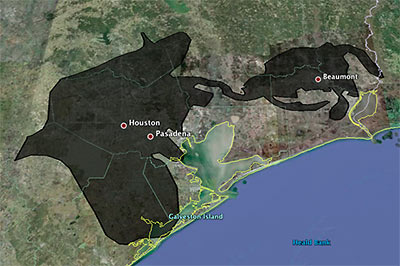
Playing around with a super-fun online tool that lets you superimpose the blobbish outline of the 2500-sq.-mile (and growing!) Gulf of Mexico oil slick from the Deepwater Horizon offshore-rig disaster onto various cities, Houstonist editor Marc Brubaker tries it on Houston — for size.
“It’s almost creepy how the slick follows I-10 out to Beaumont,” he comments. Of course, Brubaker should have nudged the oily blob a bit more to the east. Sure, he might have lost a few of those shiny exploration-company offices that have fled to the western stretches of Katy that way, but you’d be picking up lots of fun storage tanks and chug-chugging industrial plants at the northern reaches of Galveston Bay, and you’d get better coverage of Texas City, too.
Oh — but the outline is only up to date as of May 6th? Maybe we’ve got full coverage by now, then!
- Slicky Situation: The Deepwater Horizon Spill’s Actual Size [Houstonist]
- How big is the Deepwater Horizon oil spill? [Paul Rademacher]
Image: Houstonist
HOW TO PREPARE SAN JAC RIVER STEW What’s the local recipe for that San Jacinto River fishin’ favorite, toxic redfish? “The dioxins come from submerged waste pits north of the Interstate 10 bridge. McGinnes Industrial Maintenance Corp., which is no longer in business, owned and operated the pits in the 1960s, filling a 20-acre site on dry land with waste from a now-closed paper mill near the Washburn Tunnel. In the bleaching process, paper mills generated large amounts of dioxins, a family of compounds so toxic that scientists measure them in trillionths of a gram. The EPA says there is no safe level of exposure to the chemicals, which are known to cause cancer and disrupt immune and reproductive systems. The San Jacinto River began to run through the waste pits by the early 1970s because of subsidence — the sinking of soft soils as water is pumped from underground. With the McGinnes pits under water, the dioxins spread into the river and worked their way through the ecosystem, becoming more concentrated at each step in the food chain. For more than a decade, the Texas Department of Health has warned that fish and crab caught along this stretch of water, north of the Lynchburg Ferry, are tainted with cancer-causing dioxin, pesticides and PCBs. . . . In July, the EPA identified the International Paper Co. and McGinnes, which became part of Waste Management through a series of mergers and acquisitions, as the firms responsible for the dioxins problem. Under the Superfund law, the two companies will be required to evaluate and clean up the contamination. They paid about $65,000 for the fencing and roughly 50 warning signs in English, Spanish and Vietnamese, a McGinnes spokesman said.” [Houston Chronicle]
COMMENT OF THE DAY: THE UNCHARTED INNER LOOP “. . . you really haven’t got a clue if you think that suburban soil toxicity is a good reason to live inside the loop. The oldest parts of the city experienced the longest duration of industrial activity prior even to the creation of the EPA, much less even an understanding of what chemical agents were toxic. Check out the EPA’s EnviroMapper applet for an account of all known toxic waste sites (you’ll be amazed at the number), and even then bear in mind that that information is far from complete because there’s no telling what kind of crud was being mindlessly dumped on bare earth way back when and never reported. The Inner Loop isn’t supplied with well water anymore, so the toxic soils below us fortunately aren’t much of a problem…but that redeeming characteristic is shared by most of the City of Houston. The municipal water supply certainly doesn’t just abruptly stop all at once at the 610 Loop.” [TheNiche, commenting on My Toxic Houston Childhood]
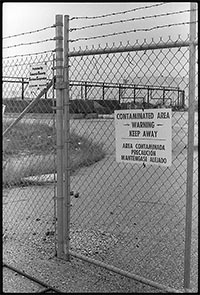
Blogger Maritza Valle grew up in Southbend, next to the Brio Superfund site, just west of San Jacinto College’s South Campus:
I lived in a toxic waste dump when I was young.
Yes, let it sink in like the waste sank into our ground and somehow contaminated the water.
When I was young, I can’t remember how young, my mother and I moved in with Gamma, my maternal grandmother. Maybe I was about 7 because my brother was there too. I still remember the address: 11606 South Arbor, Houston Texas 77089. It was a subdivision, pretty new, with a nice school just around the block, and our house had a back yard opposite a huge field. Every once in a while, men in weird space-suit looking outfits would come out and mess around with the ground, which concerned me because there were cows out there, and then leave. . . .
ANOTHER RIVER RUNS THROUGH BAYTOWN Oil spill on the bayou: “The spill spread from an oil storage tank in the Mont Belvieu area, leaking into Smith Gully then on to Cedar Bayou. Mont Belvieu’s Emergency Management Chief Bruce Oliphant said best estimates put the spilled oil at 200 to 300 gallons but said a reason for the leak had not been determined by Tuesday afternoon. ‘We’re not sure why it leaked,’ Oliphant said. ‘We couldn’t see where it was coming from the tank and maybe it was coming from somewhere underground.’†[Baytown Sun]
WEST U TREATMENT: NOW EVEN MORE SAFE AND SMELLY Noticing anything different about the area around Brays Bayou and Kirby Dr.? “‘It smells like raw sewage,’ said [nearby homeowner Hector] Caram. ‘That’s what it smells like.’ Last month, the city of West University Place cut down the thick crop of trees surrounding its sewage treatment plant on Kirby and North Braeswood within Houston city limits. And for neighbors who live, work or jog around there, the difference is jarring. “You noticed it right away,” said jogger Lauren Cozad. ‘You said, “Oh, why’d they take those trees down,” because we didn’t even know there was anything back there.’ But West University Public Works Director Chris Peifer says his city didn’t have a choice. ‘It is a secure facility,’ said Peifer. Peiffer told us the state ordered the city to clear the fence line here and increase visibility, so security guards can more easily spot anyone trying to break in there. He says it’s a matter of homeland security.” [abc13] Update: As commenter Carol notes below, the Chronicle has more on the story here.
From Downtown yesterday: Buffalo Bayou garbage flotilla!
- Crap on the Bayou [By the Bayou]
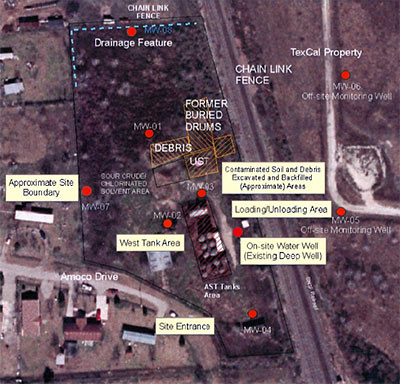
State agencies have finally caught up with the chemical soup left to seep into the soil for two decades at a 3.5-acre abandoned tank farm in south Pearland, poisoning the wells of nearby residents with high levels of lead and other contaminants. Now the Camtraco Enterprises site, at 18823 Amoco Dr. — along a rail line running west of Highway 35 — is poised to become the latest addition to Texas’s Superfund registry.
Camtraco, which operated the fuel storage, blending, and distillation facility under a series of assumed names (Beaumont Chemicals, Camtraco Chemical Corp., Glycols Inc., Mondobello Chemical Services, Picos Chemical Plant, Okemah Hydrocarbons, and Southeastern Oil Company), halted work at the site in 1992. A sampling of the chemical bouquet discovered both on- and off-site from recent TCEQ efforts: arsenic, barium, chromium, lead, mercury, bis(2-ethylhexyl)adipate, bis(2-ethylhexyl)phthalate, diethyl phthalate, di-n-butyl phthalate, methylene chloride, 1,4 dicholorobenzene, toluene, and tricholoroethene (TCE).
- Pearland Gets The State’s Newest Superfund Site! Take That, Pasadena! [Hair Balls]
- Camtraco Enterprises [TCEQ]
- Hazard Ranking System Documentation Record (PDF) [TCEQ]
Map showing the Camtraco Enterprises site’s former features: TCEQ
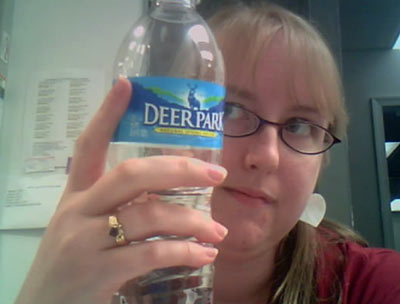
The water in Deer Park has been looking a little cloudy lately:
As Aimee Carroll pours a glass of water at her home in Deer Park, she cringes at the thought of drinking it. She says the nine people living there, including her four children, have all been sick the past few weeks.
“Nausea, diarrhea, vomiting,” she said. “My fourth grader had headaches.”
She was confused by a letter which the city sent out with water bills, saying the water had excessive levels of turbidity, that it that alone has no health effects, but that that the water could contain bacteria, viruses, and even parasites, and that those could cause all the symptoms seen at her house.
No need to worry: It’s not the water. It’s all those silly little things floating in it!
City officials say a container storing a chemical used to treat water for turbidity in Deer Park broke in late September.
- Something in the Water [abc13, via Houstonist]
Photo of Deer Park brand bottled water (not related): Flickr user Trish Heaps
IKE’S TOXIC IMPRINT “So far, regulatory officials have identified 228 sites potentially poisoned with gasoline, industrial chemicals, feces and other contaminants from Greater Houston to Lake Charles, La. But none of the reported spills is considered major, authorities said. Cmdr. Virginia Kammer, who leads the U.S. Coast Guard’s cleanup efforts along the Texas coastline, said the largest spill was about 3,000 barrels, and the responsible facility moved quickly to get the problem under control.” What about the region’s 28 Superfund sites? No word yet, but the EPA has “started to investigate.” [Houston Chronicle]
HOUSTON BAYOUS: NOW FEATURING RAW SEWAGE! “Ever since the hurricane, a number of the city’s waste water treatment plants went without power. As a result, the city was forced to actually dump raw sewage straight into the bayous. First of all, it smells awful. There have also been some oil slicks along the waterways. And you can’t miss the dead fish.” [abc13]
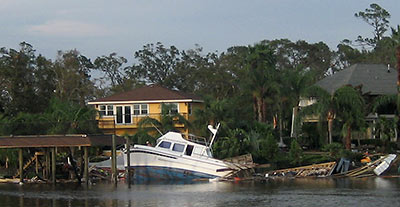
A note from the City of Taylor Lake Village:
Taylor Lake is closed to recreation – swimming, boating, fishing, and water skiing. The Gulf Coast Waste Disposal Authority industrial wastewater treatment plant on Port Road was inundated during the storm and its ponds of untreated industrial and sanitary waste overflowed into Taylor Lake. The Lake may be contaminated with industrial pollutants (volatile organic and other compounds) and bacteriological contaminants. Residents should avoid all contact with Taylor Lake water until further notice.
Any other area industrial pollutants gone AWOL after Ike? Where did they end up?
- Hurricane Ike Update [Taylor Lake Village]
Photo of house and damage on Taylor Lake: Flickr user Linda Railsback
There’s trouble in Sherwood Forest: Newman Branch, a stagnant finger of Buffalo Bayou that traipses between Little John and W. Friar Tuck Lanes, had fire hydrants running full force on Friday to flush out raw sewage that mysteriously appeared in the waterway, reports Allan Turner in the Chronicle:
Houston oilman Dewey Stringer, who lives near the point where the bayou passes Memorial, said similar pollution has periodically plagued the waterway for at least five years. Generally, however, heavy rainfall dilutes the contamination.
Stringer, who was among residents to report the pollution to authorities, said the odor was so severe that he and his wife found it difficult to sleep. He had planned to relocate to Galveston this weekend and commute to work.
Stringer said he has developed eye irritation from vapors rising from the bayou and both he and his wife have developed persistent coughs.
- Buffalo Bayou tributary flushed [Houston Chronicle]
- Sewage Contaminates Neighborhood [Houston Chronicle]

